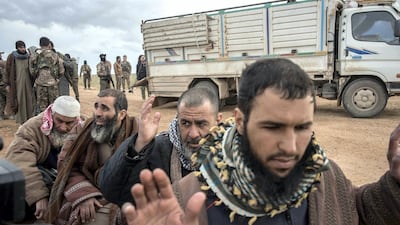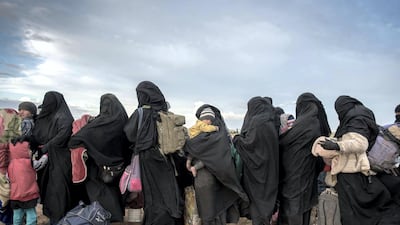Months after the Syrian Democratic Forces recaptured the last remnants of ISIS territory in Syria, the US-backed force continues to be hit by attacks. While ISIS sleeper-cells were behind many, the perpetrators of others remain unknown.
This uncertainty about the mystery attacks speaks to the deep divisions in the multi-ethnic region and to the threat from powerful neighbours who may have an interest in undermining an autonomous Kurdish region.
Kurdish officials believe the attacks seek to stoke ethnic tensions in the region.
"They're carrying them out to make disputes between all the minorities here – Kurds, Armenians, Chaldeans," Rebar Gulu, an SDF official, told The National from his office in the provincial capital of Hassakeh.
SDF officials blame Turkish intelligence for some of the unclaimed attacks, but critics say it is an attempt to detract from problems with their governance.
Meanwhile, a new, mysterious group that is vocally anti-Kurdish has emerged and started claiming some of the attacks on the SDF.
Divisions post-ISIS

ISIS swept through northern Iraq and Syria in 2014, seeking to establish a new religiously driven state. A Kurdish militia, the People’s Protection Units (YPG), had early success fighting ISIS, leading the US to arm and support them.
Turkey objected as it views the YPG as the Syrian branch of the Kurdistan Workers’ Party (PKK) which has fought an insurgency against Ankara for decades. Turkey has invaded to push the Kurdish forces out of the north-west and repeatedly threatens to invade north-east Syria to rid the border area of the YPG. The US is currently helping establish a safe zone in the north-east to avoid such a scenario.
The group denies direct links with the PKK, but there are billboards and posters of PKK founder Abdullah Ocalan all over SDF territory.
In 2015, the YPG joined Christian, Arab and Turkmen anti-ISIS forces to form the US-backed SDF. The YPG leads the group, but around half of the fighters are Arabs. The SDF, backed by the US and allied air-power, took much of the ISIS territory in Syria capturing its once self-declared capital of Raqqa.
The YPG is the armed wing of the major Kurdish political party in the region, the Democratic Union Party (PYD). They call the part of north-east Syria they now control the Autonomous Administration of North and East Syria (NES), but Kurds often refer to it as Rojava.
Opinions on the SDF in the area are mixed, especially among non-Kurdish residents. Some have accused the PYD-led administration of refusing to share power with Arabs in its territory.
Some Arab tribes in the region remain loyal to the regime of Syrian President Bashar Al Assad and are opposed to the SDF even though the government and the Kurds have not fought major battles since the uprising-turned-civil-war started in 2011.
Some tribes in Deir Ezzor province, south of Hassakeh, condemned the visit by a Saudi minister in June, citing Riyadh’s close relationship with the US, and declared their support for Mr Al Assad, according to the Lebanese outlet AlahedNews.
Many Christians support Mr Al Assad as well, including the Sootooro militia. The regime controls some Christians neighbourhoods in Hassakeh and Qamishli – cities which are otherwise ruled by mostly Kurdish officials and forces.
But opposition from non-Kurdish groups is not universal. The Syriac Military Council, which defends Christians in north-east Syria, is one of the founding members of the SDF.
"We believe that our fate is one," spokesman Orom Maroge told The National.
Rebar Gulu, SDF official
ISIS usually claims its attacks in a message through the encrypted chat service Telegram. The most recent bombing claimed by the group was in Qamishli on August 18.
Mr Gulu and other SDF officials claim that Turkey, and to a lesser extent Mr Al Assad, are behind some of the attacks ISIS doesn’t claim.
“There are two parties, Turkey and the regime, carrying out attacks in addition to ISIS,” said Mr Gulu.
Turkey has built a web of supporters in northern Syria, mostly in the country’s last major rebel-held region around Idlib in the north-west. Turkish forces built watchtowers in the region in February 2018 following an agreement with Russia.
They also back a number of Free Syrian Army factions, the once nationalist-secular armed group once largely staffed by military defectors that emerged early on in the eight-year conflict. However, at the urging of these pro-Turkish groups, the FSA clashed with the SDF and captured the city of Afrin with the backing of Ankara in 2018.
Mr Gulu admits the SDF has not secured the support of everyone in the area, but he said that Turkey and its supporters see their autonomy from both Ankara and Damascus as a threat.
“Some tribes are with Turkey, some are with us,” he said. “They don’t like our autonomy. They want to make our experiment fail.”
SDF commanders offer little by way of hard evidence of Turkey’s hand in the attacks, but messages against the force posted on Telegram by an Arabic-speaking group suggest a Turkish connection.
Since at least June, the group known as Harakat Ahrar Al Shab, which translates as “the movement to free the nation”, has been posting anti-SDF messages along with videos of bodies that it claims are SDF fighters it has killed.
‘Assassination of PKK dogs'

Little is known about Harakat Ahrar Al Shab, which says it has no affiliations and uses vague language to describe itself. The group is also active on Facebook and has more than 1,200 likes there.
Its profile picture is an image of Mr Ocalan with a handwritten note on it saying, “Harakat Ahrar Al Shab is here”.
“The assassination of a soldier of the PKK dogs,” read the description of one video posted on Telegram on August 17. The clip showed the body of a man dressed in camouflage and was purportedly shot in rural eastern Deir Ezzor.
Most of the posts of dead soldiers are in predominantly Arab areas such as Deir Ezzor and Raqqa and consistently equate the SDF to the PKK.
The Rojava Information Centre, a research group based in Qamishli that uses the Kurdish name for northeast Syria, says there is no direct evidence that Turkey backs Harakat Ahrar Al Shab, but that the scenario is likely.
"Their social media presence and knowledge of the recent history of Turkish operations on north-east Syrian soil indicates a high likelihood of Turkish intelligence involvement," Thomas McClure, a researcher at the centre, told The National.
The Rojava Information Centre noted that Harakat Ahrar Al Shab also boasts about defending Turkey’s operations in northern Syria. The capture of Afrin from the SDF came during Turkey’s Operation Olive Branch, while its Operation Euphrates Shield launched in 2016 led to Turkish-backed rebels taking other parts of northern Syria from both the SDF and ISIS.
Harakat Ahrar Al Shab, like Turkey, seeks to highlight SDF leader Mazlum Kobane’s past as a PKK fighter and paint him as a terrorist, the centre said.
Omer Ozkizilcik, analyst with the Turkey-based SETA Foundation
On July 10, the group posted a photo on Telegram of Mr Kobane reporting he was in the Qandil mountains on the Iran-Iraq-Turkey border area where the PKK has long been based.
“A member of the Kurdistan Workers’ Party (PKK) and on the international terrorism list,” the caption said.
According to Omer Ozkizilcik, an analyst based in Turkey, the attacks in north-east Syria reflect the failings of SDF’s administration.
"[It] is an attempt by the YPG to blame others but themselves," Mr Ozkizilcik, from the Turkish SETA Foundation think tank, told The National. "They should accept that their governance fuels more destabilisation in the region."
He said that SDF rule in Arab-majority areas was allowing ISIS to resurge by taking exploiting ethnic tensions and the YPG’s socialist ideology is exacerbating the situation.
“The population in YPG areas do not like the YPG’s governance, nor do they like a Marxist organisation nor do they like Kurds,” he said. “This gives ISIS the chance to exploit.”
“We’ve seen what happened in Iraq when Sunni Arabs are exploited.”
But Joshua Landis, the director of the Centre for Middle East Studies at the University of Oklahoma, told The National that it's not unusual for the SDF to point the finger at Ankara or Damascus.
“It is natural for the SDF to blame these blasts on the Turkish and Syrian governments, which are also enemies of the SDF,” he said.
While Turkey is a threat to the SDF, ISIS remains active and resurgent in northeast Syria, Mr Landis explained.
"Turkey, in particular, has been insisting that it would invade, but the war on ISIS is far from over," he said.
In the meantime, the SDF says it’s working to protect its territory.
"Our response is, 'we're a military force,'" Mustafa Bali, the head of press for the SDF, told The National from his office in Ain Issa. "We work 24 hours a day and we've thwarted some attacks."











